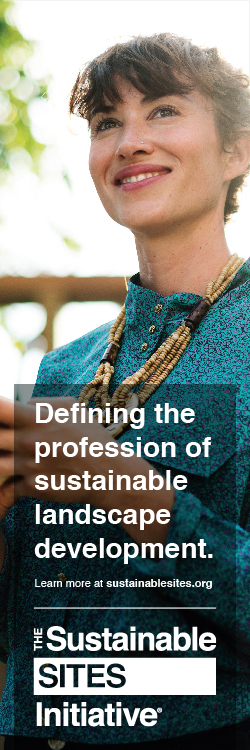Milestones and New Members
8/22/2023Leave a Comment
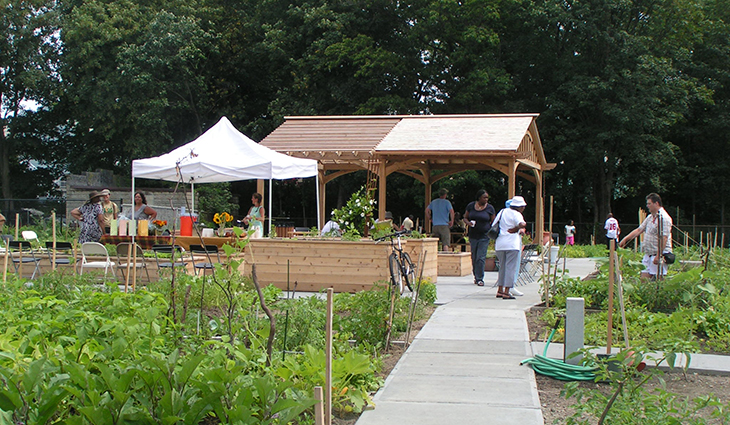
Nightingale Community Garden in Boston image provided by Paula Cortes, FASLA.
50 YEARS+
Iowa Chapter
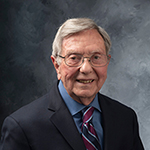
Larry T. Wilson, FASLA
Where are you from and how long have you been a landscape architect? I was born and raised in the small town of Chanute in SE Kansas. After earning a degree in landscape architecture, I worked in private and public practices in Louisville, KY, Manhattan, KS, Columbia, MO and Iowa City, IA. I have been a landscape architect for 60 years and am now retired. How did you begin your career journey in Landscape architecture? I attended Neosho County Junior College and graduated with a major in engineering. I then enrolled in electrical engineering at Kansas State University. After a year in the electrical engineering program, I enrolled in an introductory course in landscape design as an elective because of my interest in plants and art. The course opened a whole new world to me; landscape architecture became my new passion. I switched majors and continued at KSU to earn a degree in landscape architecture in 1962. I then enrolled in the LA master’s program. After two plus semesters, I withdrew to accept a position as landscape architect with a private practice firm, Miller, Wihry and Brooks, in Louisville Kentucky. Following nine years in private practice, I redirected my career path to public practice, working primarily in the areas of urban design and planning. What do you think is the most important issue facing landscape architects today? Climate change is the number one most pressing and urgent issue that we face in our profession. As we know all too well, it has quickly become the primary threat to not only the wellbeing and survival of humankind, but of all other forms of life on our planet. Landscape architects must play a significant role in preserving and protecting existing aspects of healthy ecosystems and habitats. They also have a responsibility to utilize design practices that embrace sustainability and promote restoration of threatened ecosystems. As climate change intensifies and becomes less predictable, landscape architects are well positioned to promote new thinking about addressing it and pursue innovative and sustainable strategies that are built on partnerships with other disciplines. What have you gained by being a member of ASLA for 53 years? ASLA has provided me with important and career-spanning learning experiences through conferences, seminars, continuing education and sharing of ideas and possibilities with other landscape architects in the US and elsewhere. As a life-long learner, ASLA had been my “north star” when it comes to tapping into innovation, trends, and awareness of best practices. It has helped me develop lasting friendships and professional connections. ASLA membership is a way to connect with important and accomplished landscape architects and firms that have paved the way with new ideas, solutions and landscape aesthetics that members can incorporate into their own thinking and practices. What would you share with others as a reason for belonging to ASLA as a member? ASLA is the one organization that promotes the profession of landscape architecture and collaboration with other professional societies and organizations, monitors and lobbies the US congress for or against legislation that affects landscape architects and supports licensing of LAs at the state level. ASLA provides leadership training, professional workshops and seminars, support for the state chapters and many other resources for LAs. ASLA hosts an annual meeting where LAs can meet with other professionals across the country and learn about new products directly from the companies that provide them and also learn from many experts in a wide variety of education sessions. The organization also recognizes and honors LAs with many categories of professional, leadership and design awards for outstanding accomplishments. What would you share with those new to the profession of landscape architecture? Becoming a member of ASLA will provide new LAs with countless opportunities to learn about all aspects of the profession. It helps those who are emerging LAs to connect with seasoned LAs who share areas of professional interest and career ambitions. There are so many resources to help define or reinforce one’s area of professional focus and expertise; explore them! Try to find employment opportunities that that will open up areas of practice that help you grow as a professional and might lead you to new career opportunities. Be engaged with your community and travel the world to broaden your exposure to new professional influences, design solutions and understanding of the profession. Find a mentor to help guide you as your career develops. What is your favorite project in your career and why? Would you like to submit/share a picture of it? Although, it was early in my career, one of my favorite projects is Operation Breakthrough done for the Department of Housing and Urban Development. It was my first large-scale urban development project involving collaborating with several other multidisciplinary teams in addition to our site planning team. Later, this experience opened the opportunity to accept a position as Director of Urban Design for the Louisville and Jefferson County Kentucky Planning Commission. This eventually lead to becoming Campus Landscape Architect/Planner for Kansas State University, then as Campus Planner for the University of Missouri’s four campuses (Columbia, Kansas City, St. louis and Rolla) and lastly The University of Iowa until I retired. My firm in Louisville, Miller Wihry and Brooks, was selected from 300 candidate firms to design and manage one of 10 demonstration sites across the country. Our assigned site was in Memphis Tennessee. The project was to introduce new methods and systems for construction of manufactured housing that could provide desirable and affordable housing in urban conditions for low, medium and high income residents who worked at a close-by hospital. Our site planning team was comprised of my firm’s landscape architects and engineers, a planner from Trenton, N.J., an economist from Storrs, CT, an urbanist (Senator) from Washington, DC, a noise consultant from Los Angeles, CA, an environmentalist from Louisville, KY, a structural, electrical and mechanical engineering firm from Louisville, KY, and an architectural firm from Louisville, Ky. Four systems providers selected by H.U.D. were A.S.H., for high-rise housing, Boise Cascade and General Electric for medium-rise housing and Boise Cascade for townhouses. A deck covered and hid parking for the high and medium rise area which also provided recreation space for the residents. Each of the systems had their own team of engineers, nationally recognized architectural firm and others. I lead the site planning team in developing the project site plan through site construction drawings. The housing part of the project (south of Jefferson Ave.) was built, but the commercial and recreation area (north of Jefferson Ave.) was not. The final site development plan is provided. What in your view is the most important thing that landscape architects provide? In my view, landscape architecture is the profession that has the training and expertise to design, plan and manage spaces for human use, health and enjoyment in a manner that respects and protects the natural environment to the extent possible. This includes restoration of deteriorated areas of human and natural habitats and planning for the sustainability of those habitats in the face of climate change. Is there anything else you would like to share to commemorate your 53 years with ASLA? ASLA has played an important role in guiding my career through providing learning opportunities, mentoring, leadership training, collaborating with other LAs and lasting friendships that have so very much enhanced my career and my personal life.
40 YEARS+
Boston Chapter
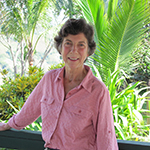
Paula V. Cortes, FASLA
Where are you from and how long have you been a landscape architect? I'm originally from Bogota, Colombia. I received my MLA from UMASS Amherst in 1974. How did you begin your career journey in Landscape architecture? In all my work, I find that having grown up in another country, with a different culture and language, has given me a global point of view and a respect for and appreciation of differences. My mother was an avid gardener and she exposed me to a love of plants and the outdoors in general. When thinking about a career, I liked the idea of being able to spend time outdoors as well as inside at a desk. Landscape architecture was a fit. At the time of my graduation the US was in an economic downturn, and there were few openings for landscape architects, especially for those just starting out. I had the good fortune to have worked after college for a small architectural practice in Cambridge, MA. I returned there to lead a project focused on historic preservation in Apalachicola, a small town in Florida. From there I went to work for the Charles River Watershed Association and several other entities before starting my own practice in 1980. In retirement I have found great satisfaction in volunteer work, especially with Mass Audubon where I chair the Design Review Advisory Committee. The work takes us to Sanctuaries in all regions of Massachusetts. What do you think is the most important issue facing landscape architects today? It's hard to say. There are so many local as well as global environmental as well as societal challenges today. We must see the larger picture with whatever our project is, work cooperatively and with respect for the local community while serving our clients in order to create an environment that will be a lasting joy for all, contributing to local wellbeing. What have you gained by being a member of ASLA for 43 years? Being a member of ASLA has meant being a member of a larger group which aspires to make communities welcoming places in which to live and work. ASLA has also been a source for information and for inspiration. What would you share with others as a reason for belonging to ASLA as a member? In addition to the above, I would say that being a member of ASLA gives credence to one's work. It also supports the larger mission of the profession. What would you share with those new to the profession of landscape architecture? There are many avenues today along which landscape architects can work. Explore the many possibilities and options available. Seek out those both inside and outside of the profession, ask a lot of questions, and be bold. Work in what gives you great pleasure and joy. Persevere. What is your favorite project in your career and why? Would you like to submit/share a picture of it? (see above) The area of my practice that has been the most rewarding is that where I worked with local residents to create and/or restore community gardens, largely in underserved neighborhoods in Boston. What in your view is the most important thing that landscape architects provide? Through everyday interaction with clients and friends, landscape architects provide knowledge about our profession and the breadth and importance of work that we do. Our work improves our local and global environment. Small scale projects are as important as the larger ones, often more so since they are central to the everyday life of the average person. It is important to explain that our projects are not immaculate conceptions. They are a product of the work of dedicated teams of designers, craftspeople, landscape contractors, and project users as well as clients and funders. Is there anything else you would like to share to commemorate your 43 years with ASLA? Our profession and its influence on local and national affairs has greatly expanded into many areas that are new and exciting. It is satisfying to be able to say that I am a member of ASLA.
30 YEARS+
Colorado and Wyoming Chapter
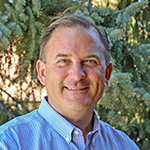
Timothy T. Nelson, ASLA
Where are you from and how long have you been a landscape architect? – I am originally from Wisconsin and received my degree in Landscape Architecture from the University of Wisconsin in 1989. I received my first registrations as a Landscape Architect from Wisconsin and Illinois consecutively when they enacted the registrations statutes around 1992. How did you begin your career journey in Landscape architecture? Initially, I worked my way through college for a landscape design/build firm in Wisconsin, first in the field of landscaping and then in their design office. I learned how to work with many different people from many different backgrounds, hard work, and customer service from that job. I have taken that with me throughout my career. I have more than 33 years of experience in land planning and landscape architecture, land-use planning, master-planned communities, commercial site planning, subdivision layout, transportation planning, and airport-associated design. In the past 33 years, I have managed projects through all phases of planning, from conceptual master planning to detailed construction documentation and specifications, including contract administration and construction observation. I have represented owners and developers at public hearings, meetings, and committees in the areas of planning and zoning processing. I also have an extensive understanding of civil engineering, multi-modal interconnection, architecture, zoning, and land-use law. I am a registered landscape architect in the State of Colorado and eight other states. Numerous local attorneys frequently request expert opinions from me for land use and eminent domain cases. In 2020, I was a guest speaker at the CLE International Eminent Domain and Land Valuation Litigation conference. What do you think is the most important issue facing landscape architects today? This is a great question that depends on the type of firm. I would say the top two are: employee retention, and more importantly the perception of the qualifications as a Landscape Architect. If you truly look at the profession of landscape architecture, it will include the planning, design, and management of land. Most Landscape Architects do not practice that way. I have focused my 33+ years of experience on a full range of site design, from the initial placement of buildings and features on the land and the design and coordination with all the related professions. I have also focused on developing younger landscape designers to do the same. It has been my experience that landscape architects are in high demand, resulting in turnover of staff. My advice it to always keep the door open for people to return. What have you gained by being a member of ASLA for 30 years? The national ASLA organization has been a great resource to support my career. I have maintained my membership because the national support I have received has been extraordinary. What would you share with others as a reason for belonging to ASLA as a member? I have always believed that being a member is important from being a student member to a full member. ASLA is the one organization that supports our profession and gives us a national credential. ASLA creates visibility and credibility to our industry, and for that, I am grateful. What would you share with those new to the profession of landscape architecture? Get with a well-rounded firm that will allow you to work on all aspects of Landscape Architecture. Take the opportunity to work closely with engineers and architects to learn their profession. Lead projects from the initial concepts through the construction. Take every opportunity to get out and see how things are built. What is your favorite project in your career and why? I have been very fortunate to work on a lot of great projects all over the country. I have planned many thousands of acres of land. My favorite is always the next site I work on, or the one that was built the most recently. I enjoy the most challenging designs, which include regional shopping centers and industrial sites. The most rewarding designs have centered around residential developments because I have designed neighborhoods where people will raise their children, shop and call home. When you look at design from that perspective, it is easy to get excited about landscape architecture. What in your view is the most important thing that landscape architects provide? I can best answer that with what my experience has been. I have spent my career helping to build the look and feel of communities – helping communities create a vision for their future. This experience is true weather working on a residential or commercial development project, but also business and industrial developments. These are places people spend a large amount of time and it is important to design even the smallest detail with that in mind.
30 YEARS
Boston Chapter
Dwight DeMay, ASLA
Colorado/Wyoming Chapter
Timothy Nelson, ASLA
New Members
Boston Chapter
Dave Andrews, ASLA
California Northern Chapter
Andrea Jean Chapman, ASLA
Julia Lindquist, Affiliate ASLA
Colorado and Wyoming Chapter
Brittany Blicharz, Affiliate ASLA
Shelbe West, Associate ASLA
Florida Chapter
Scott Christopher Heynen, ASLA
Georgia Chapter
Jason Gregory, ASLA
Jerry Young, ASLA
Hawaii Chapter
Dominic Riolo, Associate ASLA
Michigan Chapter
Katherine DeKrey, ASLA
Kevin Krogulecki, ASLA
Minnesota Chapter
Bill Delaney, ASLA
Kjersti Monson, Affiliate ASLA
North Carolina Chapter
Matt Ball, Affiliate ASLA
Potomac Chapter
Patrick Burns, Associate ASLA
Tennessee Chapter
Kayla Kramer, Associate ASLA
Texas Chapter
Alicia Deck, Affiliate ASLA
Ishita Ghosh, Associate ASLA
Wisconsin Chapter
Emmy Kriehn, Associate ASLA
International
Iftach Ari, International ASLA
Student
Cheryl Akine, Student ASLA
Randall Borrell, Student ASLA
Tommy Brown, Student ASLA
Haley Jo Christoffer, Student ASLA
Noah Cleveland, Student ASLA
Joseph Cochran, Student ASLA
Mary Cotterman, Student ASLA
Grace Donnelly, Student ASLA
Jessica Eppard, Student ASLA
Cristina Falcone, Student ASLA
Lauren Fuller, Student ASLA
Caitlin Garlow, Student ASLA
Owen Grandy, Student ASLA
Maria Gutierrez, Student ASLA
Cuahtemoc Hernandez, Student ASLA
Madison Howard, Student ASLA
Zitong Huang, Student ASLA
Isabel Iocca, Student ASLA
Nidhi Jain, Student ASLA
Elvis Leon, Student ASLA
Huitong Li, Student ASLA
Daniel Lim, Student ASLA
Vincent Lin, Student ASLA
Zoe Marans, Student ASLA
Aaron Elijah Naranjo, Student ASLA
Olivia Newroz, Student ASLA
Elise O'Brien, Student ASLA
Johanna KImberly Ortiz, Student ASLA
Anh Pham, Student ASLA
Sachida Pradhan, Student ASLA
Skylar Prewitt, Student ASLA
Halina Pyzdrowski, Student ASLA
Kennady Sloniger, Student ASLA
Charly Villalpando, Student ASLA
Laura Whitaker, Student ASLA
Wanting Zhang, Student ASLA
Student Affiliate
Mieko Henderson, Student Affil ASLA
Caroline Mitchell, Student Affil ASLA
Tomis Phuong Nguyen, Student Affil ASLA
Sina Razzaghi Asl, Student Affil ASLA
Gabriela Nicole Rose, Student Affil ASLA
Aishwarya Sreekanth, Student Affil ASLA
Student International
Zehra Caliskan, Student Intl ASLA
Muhammad Danyal, Student Intl ASLA
Gislane Maldonado, Student Intl ASLA
Nefeli Tsachalidou, Student Intl ASLA
Chen Wei, Student Intl ASLA
Yuxin Zhang, Student Intl ASLA
Wan Zijing, Student Intl ASLA


.png)
.png)
.png)
.png)
.png)
(1).png)

